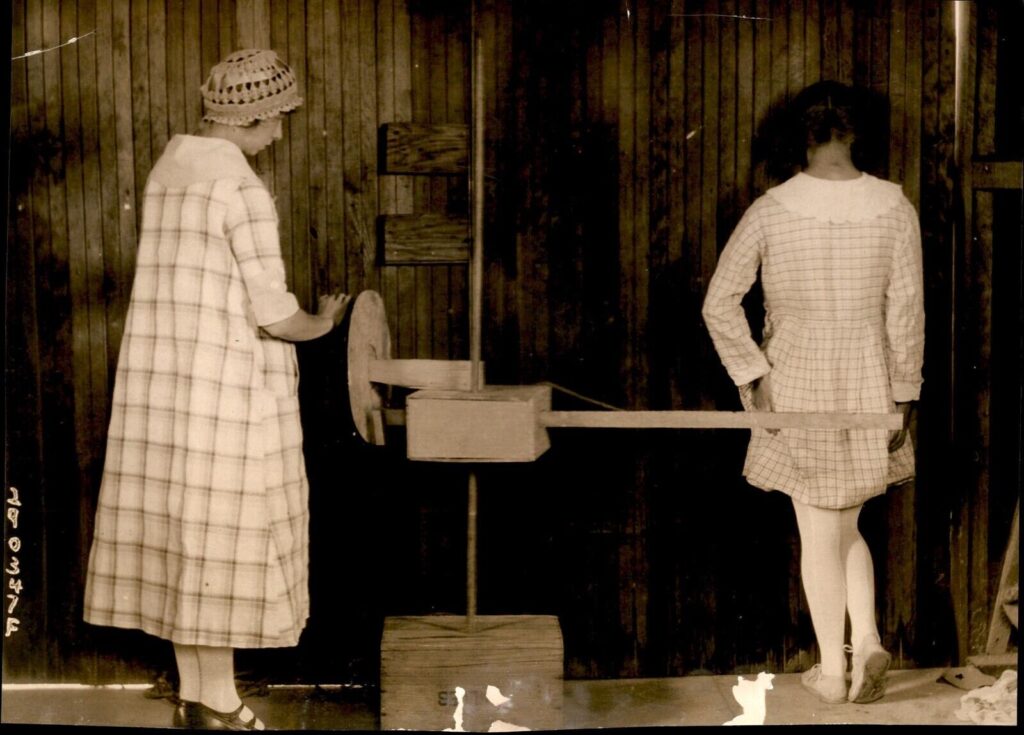Yes, it’s true, here is an image from 1922 that I recently discovered over on Ebay. Now I actually missed the auction for this picture, I happened to find this in the sold listings, but I am so glad that I went looking.
Now I’m no engineer, but, the concept to me from 100 years ago seems to have little difference to spanking machines that were made in the modern day. In this one it appears that someone turns the handle, which in turn pulls the paddle back and then at some point the paddle is released to deliver a swat. There is a pole going up the middle, but I don’t think that it has any bearing on the actual spanking device. It looks to me that it is purely there to balance the structure and is also used to hold the spanking mechanism itself.
The only question that I have, and maybe you structural engineers can help me out here, do you think that the person cranking the handle does a full turn to draw the paddle back and then releases the handle? Or, do you think that as they crank the handle there is a trigger point where the handle snaps free and is picked back up on the next rotation?
It does seem to be to be the former, only because I see a block on the spindle which would indicate a stop point when the handle is released.
Spanking machines have been on the minds of people for a long time. From the cartoon depictions of yesteryear, to the early rudimentary devices such as this one, to the many stories written about spanking machines. In fact I even have a SPANKING MACHINE STORY that I wrote myself. They have filled the fantasy mind of spankos for a long time now.
Be sure to click on the image for the full sized version, it is a large picture.
Isn’t this a great little find though? An actual spanking machine from 1922. This will be added to my WINDSOR’S SPANKING FINDS album.




Does make one wish that film existed of this gem in action! Looks like faster cranks means faster swats. It looks like there is a spring (or elastic) from the far right corner of the box to the slat that might provide the energy to swing.
Wonder if this is “Girls Gone Wild – Spring Break ’22”
Quite a wonderful find! Spanking is timeless! Thanks for sharing!
Great find! Now to answer your engineering questions:
1. The pole is indeed used only to hold up the spanking mechanism. It is rather shaky and will not resist any torque applied around the axis it defines (as for instance if the spanker were to push the wheel forward (counter-clockwise from her perspective) although I believe the spanker is to crank the wheel clockwise for reasons explained below).
2. It appears to me a swat will be applied if the wheel is cranked in either direction. However, as Warmhand points out, there is some sort of elastic band between the corner of the box and the paddle-arm. To stretch that elastic, the wheel would have to be cranked clockwise so the block contacts the side of the paddle-arm facing us, causing the arm to be drawn back. The photo shows the action just before this happens. Eventually, the block slides past the paddle-arm, allowing the elastic to snap the arm forwards and apply it to the target. Thus the spanker cranks the handle until the arm snaps free.
This type of lever increases speed at the expense of force (much like the human forearm), so you would need a very strong elastic – stronger than this one appears to be – to apply a swat with effective force. Note that in this case the power of the swat depends only on the strength of the elastic and not on the speed with which the wheel is cranked.
If the wheel were cranked counter-clockwise, it would contact the forward face of the paddle-arm and drive the business end of the arm directly into the spankee’s rear end, but without any help from the elastic, so the force of the swat would depend entirely on the speed with which the wheel is cranked. And the spanker would absorb a good deal of impact.
Fun as spanking machines are in the imagination, I’m a hands-on (or paddles-on) guy myself and prefer to control the implement (hand, paddle, or cane) myself rather than use a machine for an intermediary.